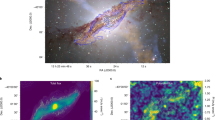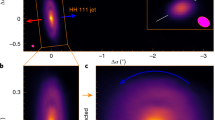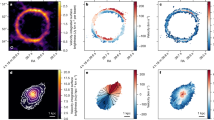Abstract
The disk of the Milky Way contains free electrons and magnetic fields which contribute significantly to the energetics of the interstellar medium1. The concentrations of electrons and magnetic fields are too low to be detected by direct methods, but may be investigated using Faraday rotation, a wavelength-dependent shift in linear polarization angle induced by a magneto-ionic medium2. Structures in polarization angle arising from Faraday rotation have been detected recently at long radio wavelengths3. These structures are disorganized and filamentary, probably arising from interstellar gas in the vicinity of the Sun. Here we report a more distant, highly ordered Faraday-rotation structure of elliptical shape, with its long axis parallel to the plane of the Galaxy. The feature appears to be located in an inter-arm region of the Milky Way, between the spiral arm containing the Sun and the next outer (Perseus) spiral arm. Within the elliptical region, small-scale structure which characterizes the turbulence seen in adjacent regions of the interstellar medium is absent. The origin of this magneto-ionic feature is uncertain, but it must arise from an organization of the magnetic-field and electron-density distributions on a scale of the order of 50 parsecs (165 light years).
This is a preview of subscription content, access via your institution
Access options
Subscribe to this journal
Receive 51 print issues and online access
$199.00 per year
only $3.90 per issue
Buy this article
- Purchase on Springer Link
- Instant access to full article PDF
Prices may be subject to local taxes which are calculated during checkout


Similar content being viewed by others
References
Jura, M. in Interstellar Processes (eds Hollenbach, D. J. & Thronson, H. A. Jr) 3–17 (Reidel, Dordrecht, (1987)).
Lang, K. R. Astrophysical Formulae (Springer, Berlin, (1974)).
Wieringa, M. H., de Bruyn, A. G., Jansen, D., Brouw, W. N. & Katgert, P. Small scale polarization structure in the diffuse galactic emission at 325 MHz. Astron. Astrophys. 268, 215–229 (1993).
Normandeau, M., Taylor, A. R. & Dewdney, P. E. The Dominion Radio Astrophysical Observatory Galactic Plane Survey pilot project: the W3/W4/W5/HB3 region. Astrophys. J. Suppl. 108, 279–299 (1997).
Smegal, R. J., Landecker, T. L., Vaneldik, J. F., Routledge, D. & Dewdney, P. E. Aperture synthesis polarimetry: application to the Dominion Radio Astrophysical Observatory synthesis telescope. Radio Sci. 32, 643–656 (1997).
Salter, C. J. & Brown, R. L. in Galactic and Extragalactic Radio Astronomy 2nd edn (eds Verschuur, G. L. & Kellermann, K. I.) 1–36 (Springer, New York, (1988)).
Westerhout, G. Asurvey of the continuous radiation from the Galactic system at a frequency of 1390 Mc/s. Bull. Astron. Inst. Neth. 14, 215–260 (1958).
Gardner, F. F. & Whiteoak, J. B. Polarization of cosmic radio waves. Annu. Rev. Astron. Astrophys. 4, 245–292 (1966).
Braunsfurth, E. Neutral hydrogen in the Cas OB6 association. Astron. Astrophys. 117, 297–303 (1983).
Broten, N. W., McLeod, J. M. & Vallée, J. P. Catalogue of unambiguous (Faraday-thin, one-component, spectrum-selected) rotation measures for galaxies and quasars. Astrophys. Space Sci. 141, 303–331 (1988).
Vallée, J. P. in Fundamentals of Cosmic Physics Vol. 19, 1–89 (Gordon & Breach, Amsterdam, (1988)).
Taylor, J. H. & Cordes, J. M. Pulsar distances and the Galactic distribution of free electrons. Astrophys. J. 411, 674–684 (1993).
Rand, R. J. & Kulkarni, S. R. The local Galactic magnetic field. Astrophys. J. 343, 760–772 (1989).
Beck, R. & Hoernes, P. Magnetic spiral arms in the galaxy NGC6946. Nature 379, 47–49 (1996).
Fan, Z. & Lou, Y.-Q. Origin of the magnetic spiral arms in the galaxy NGC4946. Nature 383, 800–802 (1996).
Wilkinson, A. & Smith, F. G. Characteristics of the local Galactic magnetic field determined from background polarization surveys. Mon. Not. R. Astron. Soc. 167, 593–611 (1974).
Beuermann, K., Kanbach, G. & Berkhuijsen, E. M. Radio structure of the Galaxy: thick disk and thin disk at 408 MHz. Astron. Astrophys. 153, 17–34 (1985).
Digel, S. W., Lyder, D. A., Philbrick, A. J., Puche, D. & Thaddeus, P. Alarge-scale CO survey towards W3, W4, and W5. Astrophys. J. 458, 561–575 (1996).
Leahy, J. P. Small-scale variations in Galactic Faraday rotation. Mon. Not. R. Astron. Soc. 226, 433–446 (1987).
Brouw, W. N. & Spoelstra, T. A. Th. Linear polarization of the Galactic radio emission at frequencies between 408 and 1411 MHz. Reductions. Astron. Astrophys. Suppl. Ser. 26, 129–146 (1976).
Kallas, E. & Reich, W. A21 cm radio continuum survey of the Galactic Plane between l = 93° and l = 162°. Astron. Astrophys. Suppl. Ser. 42, 227–243 (1980).
Roger, R. S. Low frequency absorption due to IC1805 and IC1848. Astrophys. J. 155, 831–840 (1969).
Dubois, P. in Library and Information Services in Astronomy (eds Wilkins, G. A. & Stevens-Rayburn, S.) 146 (US Naval Observatory, Washington DC, (1988)).
Dyson, J. E. & Williams, D. A. Physics of the Interstellar Medium 173 (Wiley, New York, (1980)).
Acknowledgements
We thank M. Normandeau (Univ. Calgary; now Univ. California at Berkeley) for the acquisition and initial processing of the data, and A. G. Willis (DRAO) for some later processing. The Dominion Radio Astrophysical Observatory is operated as a national facility by the National Research Council of Canada. The Canadian Galactic Plane Survey is a Canadian project with international partners, and is supported by the Natural Sciences and Engineering Research Council of Canada.
Author information
Authors and Affiliations
Corresponding author
Rights and permissions
About this article
Cite this article
Gray, A., Landecker, T., Dewdney, P. et al. A large-scale, interstellar Faraday-rotation feature of unknown origin. Nature 393, 660–662 (1998). https://doi.org/10.1038/31413
Received:
Accepted:
Issue Date:
DOI: https://doi.org/10.1038/31413
This article is cited by
Comments
By submitting a comment you agree to abide by our Terms and Community Guidelines. If you find something abusive or that does not comply with our terms or guidelines please flag it as inappropriate.



